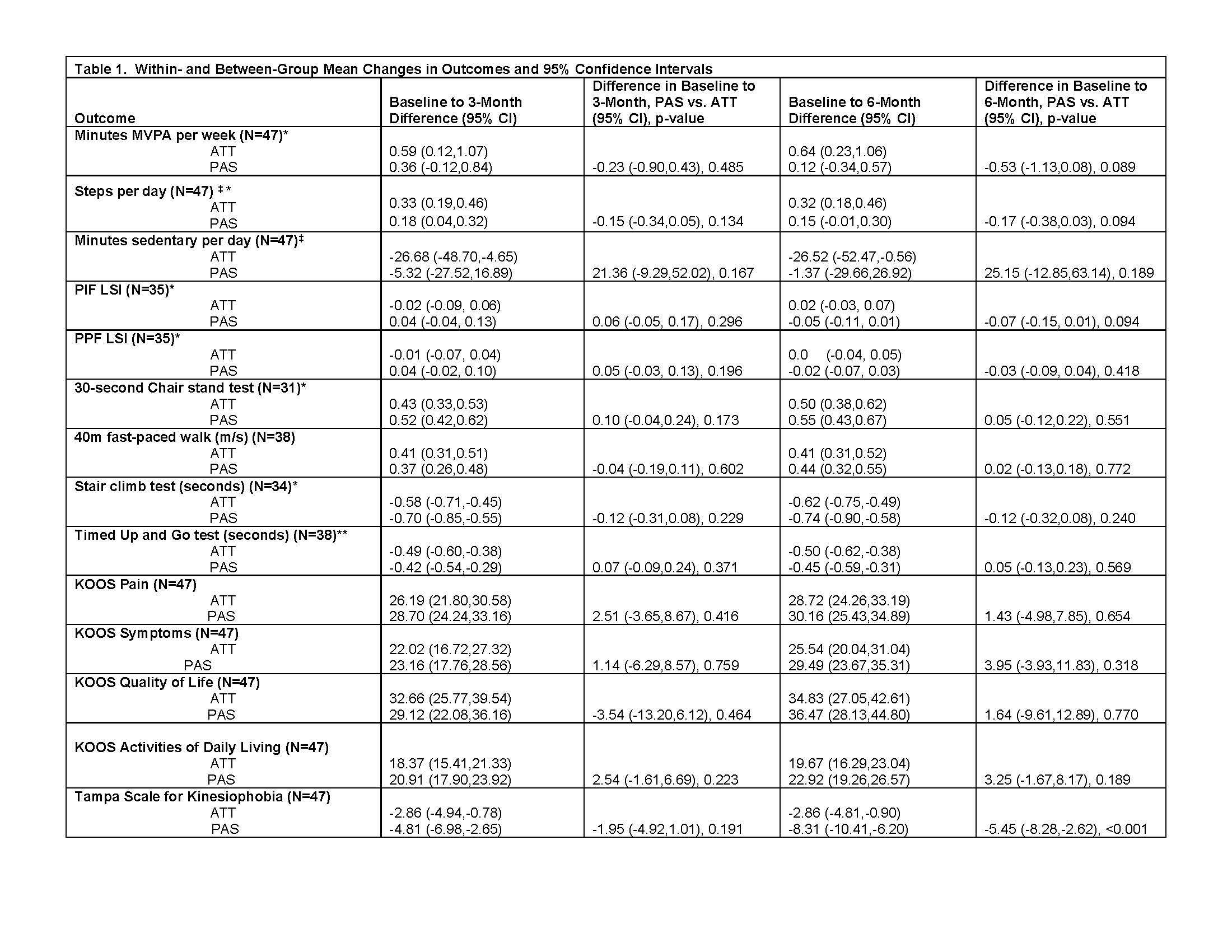Session Information
Date: Sunday, November 17, 2024
Title: Orthopedics, Low Back Pain, & Rehabilitation – ACR/ARP Poster
Session Type: Poster Session B
Session Time: 10:30AM-12:30PM
Background/Purpose: Studies have identified two key deficits in individuals’ activity-related trajectories following total knee arthroplasty (TKA). First, overall physical activity (PA) levels remain very low. Second, many patients continue to demonstrate movement asymmetries that result in greater load on the non-surgical limb. This exploratory trial examined a novel Physical Activity and Symmetry (PAS) intervention focused on addressing these two common deficits.
Methods: Participants (n=60) were enrolled during outpatient physical therapy (PT) following TKA and randomized to the PAS intervention or an attention (ATT) control group. The PAS intervention included physical activity counseling and balance exercises to address joint loading symmetry; content was delivered during routine PT sessions plus supplemental sessions 4-weeks and 8-weeks following PT discharge. The ATT control condition included supplemental sessions at 4-weeks and 8-weeks focused on general evaluation of surgical recovery benchmarks. Primary outcomes were weekly minutes of moderate to vigorous physical activity (MVPA, measured with an accelerometer), and peak force loading symmetry (limb symmetry index; LSI) during a 10m walk, measured with a 3-sensor in-shoe device. Secondary outcomes are shown in Table 1. General linear mixed effects models compared mean between- and within-group changes in outcomes at 3-month and 6-month follow-up.
Results: The mean age of participants was 66.2 years (standard deviation = 7.5), and 61.7% were women. Table 1 shows within- and between-group mean change in primary and secondary outcomes at 3- and 6-month follow-up, and Table 2 shows raw accelerometer data over time (as these values had to be transformed for statistical analyses). Both PAS and ATT groups increased MVPA, but these changes were not statistically or clinically different between groups at 3-month or 6-month follow-up (p >0.05). There were also no statistically or clinically meaningful between-group differences in mean LSI change scores between baseline and 3-month or 6-month follow-up during a 10m meter walk (p >0.05). Among secondary outcomes, only the Tampa Scale for Kinesophobia at 6-month follow-up differed significantly between PAS and ATT groups.
Conclusion: The PAS intervention did not yield improvements beyond the ATT control condition. It is possible that delaying delivery of PAS components until physical recovery plateaus or a more intensive intervention (e.g., more visits or guidance for exercise progression) may be needed to further improve outcomes following TKA.
To cite this abstract in AMA style:
Allen K, Arbeeva L, Bracey D, Hales D, Hill C, Huffman K, Schwartz T, Queen R. Physical Activity and Symmetry Following Total Knee Arthroplasty:Results of an Exploratory Trial [abstract]. Arthritis Rheumatol. 2024; 76 (suppl 9). https://acrabstracts.org/abstract/physical-activity-and-symmetry-following-total-knee-arthroplastyresults-of-an-exploratory-trial/. Accessed .« Back to ACR Convergence 2024
ACR Meeting Abstracts - https://acrabstracts.org/abstract/physical-activity-and-symmetry-following-total-knee-arthroplastyresults-of-an-exploratory-trial/


